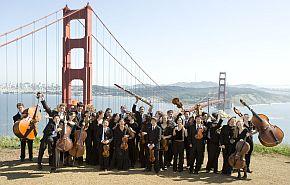
The program opened with Samuel Barber’s Symphony No. 1, Op. 9, followed by an uncommonly elegant performance of Hector Berlioz’ Symphony fantastique, Op. 14. But just before the Berlioz performance was to begin, lights in the hall started flashing along with a clanking noise. The management made an announcement that there was “a fire incident” and that the hall should be evacuated, with the customary warming not to use the elevators.
This was done in so orderly a fashion that you might think the audience had been rehearsing evacuations for months. We were outside for only a brief time — perhaps 10 minutes or so, which was made dramatic by the arrival of a hook and ladder fire truck on Van Ness. It turned out to be some sort of systems failure in the hall. Who knows? It might have been the performance of the Barber First that caused the system to faint.
Underappreciated Masterwork

Barber’s First Symphony is one of the first great American symphonies, combining the heroics of Mahler with a lyricism equal to the best moments in Brahms or Tchaikovsky. He wrote the piece in 1938 and saw it premiered in Rome. Barber then rewrote it in 1942-43, adding a different scherzo. Bruno Walter premiered that version and recorded it for Columbia with the New York Philharmonic in 1944.
Although published in one movement, the work is actually in four, which are played without pause. The opening, dark Allegro is followed by a whizbang scherzo, brimming with glittering stutters in tarantella style, plus heroic fanfares from the horns and timpani. Then comes a gloriously rich Andante and a passacaglia finale grounded on the symphony’s opening theme.
I was apprehensive about whether the young musicians could manage this virtuoso work. Although relatively short, at about 20 minutes, it’s terribly difficult. Every section is shoved to the edge of the cliff of unplayable, which is why the piece is so seldom programmed. But not to worry. The young musicians had it down, even the many first desk solos, and played with almost Mahlerian intensity.
Shwartz awarded bows both to important soloists — especially English horn and first bassoon players — and the various sections. All were greeted with deserved standing ovations. I’ll never doubt them again.
Serenely Lyrical Fantastic Symphony
Yet even their accomplishment in the Barber was topped by the Berlioz performance. This was a jaw dropper, not just for its brilliance but even more for its finesse. Hats off to Shwartz for realizing that Berlioz was much more than a bad-boy composer. Beyond the bravura and noisy bluster, he was a quite elegant composer.
Shwartz’s reading emphasized proper dynamics, especially during the soft and ultrasoft passages. After all, few composers wrote “pianissimo” as often as Berlioz. The musicians responded, conveying the work’s lyricism. Everything was precisely in place, nothing overplayed. Anyone can make noise, but it takes high musicianship to play with beautiful serenity and quiet.
In the last two movements, “March to the Scaffold” and “Dream of a Witches’ Sabbath,” you can be rambunctious as all hell. The orchestra took Berlioz by the horns (so to speak), as the musicians obviously enjoyed their own accomplishments. I noticed some of them swaying to the pulse of the music, obviously caught up in the emotions of the moment.
Yet even here, there was great eloquence. There were all sorts of subtle touches, and from unexpected sources. The cymbal player, for instance, made his instruments emit an elegant glimmer rather than a clank. (As a percussionist myself, I can tell you that making the cymbals “sing” is extremely difficult to pull off.)
Nor did the brass blare nor the strings lose their warmth of timbre when being pressed to the wall. Nowhere in the orchestra was there a hint of exaggeration beyond that which the composer asks for. As another nice touch, Shwartz took the repeats of the first and fourth movements, which do help balance out the whole of the work. Everyone left smiling with delight for an outstanding event so artistically presented. Mark them down an A+.

